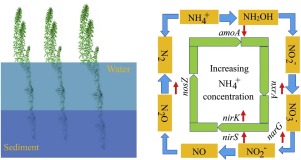当前位置:
X-MOL 学术
›
Process Biochem.
›
论文详情
Our official English website, www.x-mol.net, welcomes your
feedback! (Note: you will need to create a separate account there.)
Dynamic variations of microbial community structure in Myriophyllum aquaticum constructed wetlands in response to different NH4+-N concentrations
Process Biochemistry ( IF 3.7 ) Pub Date : 2020-06-01 , DOI: 10.1016/j.procbio.2020.02.028 Lina Xu , Bao Zhang , Xiawei Peng , Xupo Zhang , Bo Sun , Haishu Sun , Cancan Jiang , Sining Zhou , Xiangui Zeng , Zhihui Bai , Shengjun Xu , Xuliang Zhuang
Process Biochemistry ( IF 3.7 ) Pub Date : 2020-06-01 , DOI: 10.1016/j.procbio.2020.02.028 Lina Xu , Bao Zhang , Xiawei Peng , Xupo Zhang , Bo Sun , Haishu Sun , Cancan Jiang , Sining Zhou , Xiangui Zeng , Zhihui Bai , Shengjun Xu , Xuliang Zhuang

|
Abstract Constructed wetlands (CWs) have received increasing attentions for their N removal performances, especially regarding NH4+-N. Different influent NH4+-N concentration may influence N removal efficiency in practice, while the effects of different NH4+-N concentrations on microorganisms removing N in CWs are poorly understood. In this study, surface flow CWs planted with Myriophyllum (M). aquaticum were established to investigate the influences of different NH4+-N concentrations on the composition, structure, and interactions of microbial community. Our findings suggested 105 mg/L NH4+-N CWs achieved highest N removal rate, removing 89.30 % NH4+-N and 92.34 % TN from the influent. The results of real-time quantitative polymerase chain reactions (qPCR) indicated abundances of nitrifying genes (nxrA) and denitrifying genes (narG, nirS, nirK, and nosZ) were increased by increasing NH4+-N concentrations, and the strongest effects were observed in narG (8-fold) and nosZ genes (11-fold). Different NH4+-N concentrations was proved to alter composition and structure of microbial communities via high-throughput sequencing, e.g. denitrifiers including Brevendomonas.sp, Dokdonella.sp and Rhodococcus.sp were enriched obviously with increasing NH4+-N concentrations. In addition, network showed interactions among microbial populations and positive interactions were dramatically shifted and enhanced by increasing NH4+-N concentrations.
中文翻译:

不同NH4+-N浓度下水生狐尾藻人工湿地微生物群落结构的动态变化
摘要 人工湿地(CWs)因其脱氮性能受到越来越多的关注,尤其是对 NH4+-N 的去除。在实践中,不同的进水 NH4+-N 浓度可能会影响 N 去除效率,而不同 NH4+-N 浓度对 CW 中微生物去除 N 的影响知之甚少。在这项研究中,地表流 CWs 种植了狐尾兰 (M)。建立水生植物以研究不同 NH4+-N 浓度对微生物群落组成、结构和相互作用的影响。我们的研究结果表明,105 mg/L NH4+-N CW 实现了最高的 N 去除率,从进水中去除了 89.30% NH4+-N 和 92.34% TN。实时定量聚合酶链反应 (qPCR) 的结果表明硝化基因 (nxrA) 和反硝化基因 (narG、nirS、nirK、和 nosZ)随着 NH4+-N 浓度的增加而增加,并且在 narG(8 倍)和 nosZ 基因(11 倍)中观察到最强的影响。通过高通量测序证明不同的NH4+-N浓度会改变微生物群落的组成和结构,例如随着NH4+-N浓度的增加,包括Brevendomonas.sp、Dokdonella.sp和Rhodococcus.sp在内的反硝化菌明显富集。此外,网络显示微生物种群之间的相互作用和正相互作用随着 NH4+-N 浓度的增加而显着转移和增强。通过高通量测序证明不同的NH4+-N浓度会改变微生物群落的组成和结构,例如随着NH4+-N浓度的增加,包括Brevendomonas.sp、Dokdonella.sp和Rhodococcus.sp在内的反硝化菌明显富集。此外,网络显示微生物种群之间的相互作用和正相互作用随着 NH4+-N 浓度的增加而显着转移和增强。通过高通量测序证明不同的NH4+-N浓度会改变微生物群落的组成和结构,例如随着NH4+-N浓度的增加,包括Brevendomonas.sp、Dokdonella.sp和Rhodococcus.sp在内的反硝化菌明显富集。此外,网络显示微生物种群之间的相互作用和正相互作用随着 NH4+-N 浓度的增加而显着转移和增强。
更新日期:2020-06-01
中文翻译:

不同NH4+-N浓度下水生狐尾藻人工湿地微生物群落结构的动态变化
摘要 人工湿地(CWs)因其脱氮性能受到越来越多的关注,尤其是对 NH4+-N 的去除。在实践中,不同的进水 NH4+-N 浓度可能会影响 N 去除效率,而不同 NH4+-N 浓度对 CW 中微生物去除 N 的影响知之甚少。在这项研究中,地表流 CWs 种植了狐尾兰 (M)。建立水生植物以研究不同 NH4+-N 浓度对微生物群落组成、结构和相互作用的影响。我们的研究结果表明,105 mg/L NH4+-N CW 实现了最高的 N 去除率,从进水中去除了 89.30% NH4+-N 和 92.34% TN。实时定量聚合酶链反应 (qPCR) 的结果表明硝化基因 (nxrA) 和反硝化基因 (narG、nirS、nirK、和 nosZ)随着 NH4+-N 浓度的增加而增加,并且在 narG(8 倍)和 nosZ 基因(11 倍)中观察到最强的影响。通过高通量测序证明不同的NH4+-N浓度会改变微生物群落的组成和结构,例如随着NH4+-N浓度的增加,包括Brevendomonas.sp、Dokdonella.sp和Rhodococcus.sp在内的反硝化菌明显富集。此外,网络显示微生物种群之间的相互作用和正相互作用随着 NH4+-N 浓度的增加而显着转移和增强。通过高通量测序证明不同的NH4+-N浓度会改变微生物群落的组成和结构,例如随着NH4+-N浓度的增加,包括Brevendomonas.sp、Dokdonella.sp和Rhodococcus.sp在内的反硝化菌明显富集。此外,网络显示微生物种群之间的相互作用和正相互作用随着 NH4+-N 浓度的增加而显着转移和增强。通过高通量测序证明不同的NH4+-N浓度会改变微生物群落的组成和结构,例如随着NH4+-N浓度的增加,包括Brevendomonas.sp、Dokdonella.sp和Rhodococcus.sp在内的反硝化菌明显富集。此外,网络显示微生物种群之间的相互作用和正相互作用随着 NH4+-N 浓度的增加而显着转移和增强。











































 京公网安备 11010802027423号
京公网安备 11010802027423号